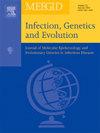Discovery of tobacco necrosis virus A in a diseased Colombian Cannabis sativa plant
IF 2.6
4区 医学
Q3 INFECTIOUS DISEASES
引用次数: 0
Abstract
Plant viral infections pose a significant threat to global crop productivity. Despite their profound impact on agriculture, plant viruses have been relatively understudied, primarily due to technological limitations associated with classical molecular methods. However, the advent of RNA Next-Generation Sequencing (NGS) RNA-seq analysis has revolutionized virus characterization in environmental settings, overcoming previous limitations and providing a powerful tool for studying plant viruses.
In an RNA-seq experiment conducted on a diseased Colombian Cannabis sativa hemp plant, we identified a linear positive-sense single-stranded RNA genome belonging to Tobacco Necrosis Virus A (TNV-A), a common cause of necrotic lesions in plants such as tobacco and tulipa. The affected Cannabis sativa hemp plant exhibited severe symptoms, including alterations in pigmentation, leaf morphology such as chlorosis, necrotic tissue formation, and surface wear on the leaves. The complete genome sequence of the Cannabis sativa TNV-A was 3656 nucleotides long, containing five putative ORFs, and was classified in the family Tombusviridae, genus Alphanecrovirus, and belonging to the Necro-like clade based on RdRp protein phylogenetic analysis. Our analysis revealed a well-conserved RdRp protein among the Alphanecroviruses, with 89 % of the amino acid residues in the peptide being entirely conserved. In contrast, the coat protein exhibited significantly higher variability, with only 49.3 % of the residues being 100 % conserved. Regarding the viral genome expression of Cannabis sativa TNV-A, we observed that the virus was highly abundant in the leaves of the diseased plant, ranking among the topmost abundant transcripts, occupying the percentile position of 3 %. Overall, our study generated the first reference genome of TNV-A virus in the tropical region and reported the first case of this virus infecting a Cannabis sativa plant.
烟草坏死病毒A在患病哥伦比亚大麻植物中的发现
植物病毒感染对全球作物生产力构成重大威胁。尽管植物病毒对农业产生了深远的影响,但由于传统分子方法的技术限制,对它们的研究相对不足。然而,RNA下一代测序(NGS) RNA-seq分析的出现彻底改变了病毒在环境设置中的表征,克服了以前的局限性,为研究植物病毒提供了一个强大的工具。在对患病的哥伦比亚大麻植物进行的RNA-seq实验中,我们发现了属于烟草坏死病毒a (TNV-A)的线性正义单链RNA基因组,TNV-A是烟草和郁金香等植物坏死病变的常见原因。受影响的大麻植物表现出严重的症状,包括色素沉着、叶片形态(如褪绿、坏死组织形成)的改变和叶片表面磨损。大麻TNV-A的全基因组序列长3656个核苷酸,包含5个推定的orf,根据RdRp蛋白系统发育分析,将其归为tombusvirridae, alphanecorvirus属,属于necro样枝。我们的分析显示,在甲型病毒中存在一种保守性较好的RdRp蛋白,其肽中89%的氨基酸残基是完全保守的。相比之下,外壳蛋白表现出明显更高的可变性,只有49.3%的残基是100%保守的。关于大麻TNV-A的病毒基因组表达,我们观察到该病毒在病株叶片中非常丰富,在转录本中丰度最高,占3%的百分位。总的来说,我们的研究在热带地区产生了TNV-A病毒的第一个参考基因组,并报道了该病毒感染大麻植物的第一例。
本文章由计算机程序翻译,如有差异,请以英文原文为准。
求助全文
约1分钟内获得全文
求助全文
来源期刊

Infection Genetics and Evolution
医学-传染病学
CiteScore
8.40
自引率
0.00%
发文量
215
审稿时长
82 days
期刊介绍:
(aka Journal of Molecular Epidemiology and Evolutionary Genetics of Infectious Diseases -- MEEGID)
Infectious diseases constitute one of the main challenges to medical science in the coming century. The impressive development of molecular megatechnologies and of bioinformatics have greatly increased our knowledge of the evolution, transmission and pathogenicity of infectious diseases. Research has shown that host susceptibility to many infectious diseases has a genetic basis. Furthermore, much is now known on the molecular epidemiology, evolution and virulence of pathogenic agents, as well as their resistance to drugs, vaccines, and antibiotics. Equally, research on the genetics of disease vectors has greatly improved our understanding of their systematics, has increased our capacity to identify target populations for control or intervention, and has provided detailed information on the mechanisms of insecticide resistance.
However, the genetics and evolutionary biology of hosts, pathogens and vectors have tended to develop as three separate fields of research. This artificial compartmentalisation is of concern due to our growing appreciation of the strong co-evolutionary interactions among hosts, pathogens and vectors.
Infection, Genetics and Evolution and its companion congress [MEEGID](http://www.meegidconference.com/) (for Molecular Epidemiology and Evolutionary Genetics of Infectious Diseases) are the main forum acting for the cross-fertilization between evolutionary science and biomedical research on infectious diseases.
Infection, Genetics and Evolution is the only journal that welcomes articles dealing with the genetics and evolutionary biology of hosts, pathogens and vectors, and coevolution processes among them in relation to infection and disease manifestation. All infectious models enter the scope of the journal, including pathogens of humans, animals and plants, either parasites, fungi, bacteria, viruses or prions. The journal welcomes articles dealing with genetics, population genetics, genomics, postgenomics, gene expression, evolutionary biology, population dynamics, mathematical modeling and bioinformatics. We also provide many author benefits, such as free PDFs, a liberal copyright policy, special discounts on Elsevier publications and much more. Please click here for more information on our author services .
 求助内容:
求助内容: 应助结果提醒方式:
应助结果提醒方式:


